As parents, we’ve discovered that newborn babies love to fall asleep in their arms. Babies feel comforted by the warmth of their parents, and it’s the easiest way to get them to sleep. However, as they get older and heavier, it’s not practical to hold our babies every time they go to sleep.
Newborn babies need to feel close to their parents, so it’s good for them to sleep in their arms. However, teaching babies how to fall asleep independently after three months is better as it improves sleep quality. We can do this by using methods that teach them how to self-soothe.
As babies age, they form habits quickly, and before we know it, our babies will be so used to sleeping in our arms that they won’t be able to sleep alone. So, if we find ourselves holding them for hours, we might wonder if getting our babies to sleep without holding them is possible.
Let’s learn how to break a baby’s habit of sleeping in our arms and improve sleep for our babies and us – here is some vital information.
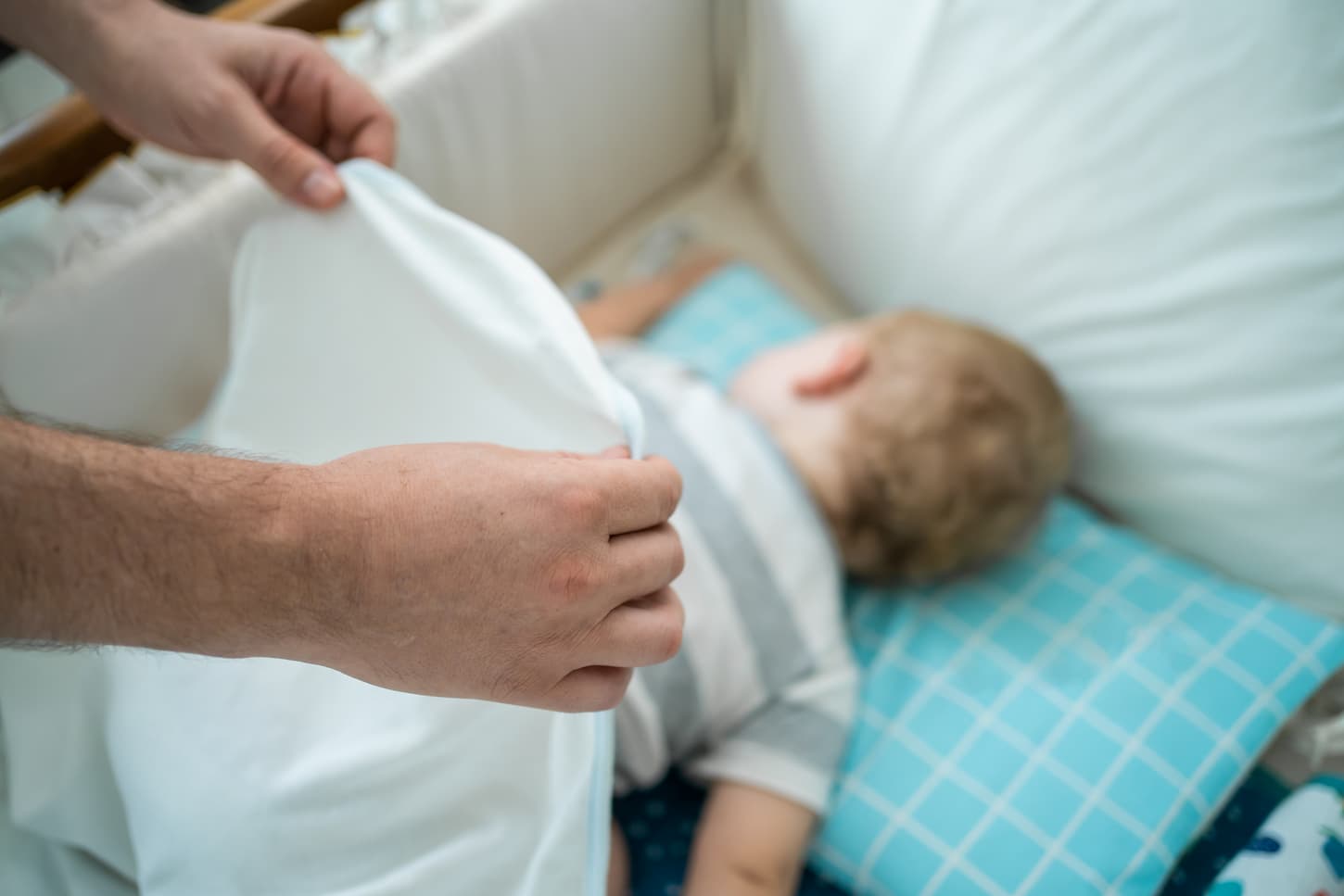
Is it Bad for a Baby to Sleep in Your Arms?
Newborns are okay to fall asleep being held, but babies older than 12-16 weeks ought not to fall asleep being held all the time because they might become dependent on it to sleep, and it may decrease their overall sleep quality.
Most newborns spend a lot of time in their parent’s arms. It’s a natural instinct for most parents to want to hold and rock their new baby. However, in their first weeks, babies slowly adapt to life outside the womb and need to be close to their parents to feel safe and secure.
In addition, holding newborn babies while they go asleep can be good for their development.
From about 12 weeks old, babies don’t need as much physical attention from their parents. If older babies won’t fall asleep unless they’re in our arms, it’s a bad habit that’s not good for the health and welfare of the baby or parents.
Some parents spend hours holding or rocking their babies until they fall asleep, which isn’t very practical, especially as a baby gets older.
Another reason it’s not good for babies to fall asleep in their parent’s arms is it can increase the risk of Sudden Infant Death Syndrome.
The American Association of Pediatrics (AAP) recommends that babies always sleep on a firm, flat surface on their back to reduce the risk of SIDS.
When Should you Stop Letting a Baby Sleep in Your Arms?
Depending on their development, parents should generally stop letting babies sleep in their arms when they are about 12 weeks old. After 12 weeks, encourage and transition babies to sleep in their crib rather than in their parent’s arms.
At about 2 months old, babies develop their circadian rhythm, which means they get a sense of day and night and start forming sleep patterns. Most babies can self-soothe from 3 or 4 months old – most babies can do this, so it’s the perfect time to teach them how to fall asleep without our help.
Another reason to teach babies how to sleep independently from around three months old is that they sleep better. Babies who depend on holding, rocking, or feeding to fall asleep don’t get a decent quality of sleep – and neither do their parents.
What to Do if your Baby Will Only Sleep Being Held
If a baby is 12 weeks old and won’t go to sleep unless held, encourage them to self-soothe. Some babies are natural self-soothers, while we must teach others this skill, usually through one of the many sleep training methods.
From around 3 or 4 months old, most babies can self-soothe, which means they can soothe themselves back to sleep without any assistance. Self-soothing is an essential milestone in a baby’s development – it helps them and their parents sleep better.
A baby that can self-soothe gently babble to themselves contentedly in their crib rather than cry out for attention. They might suck their fingers or toes to soothe themselves or knock their limbs rhythmically on the bed.
If a baby doesn’t show self-soothing after three or 4-months old, we can help them learn how. First, give the baby the opportunity to self-soothe. Then, if they don’t have an urgent need, such as feeding or a diaper change, it’s okay to leave them to cry for a few minutes before picking them up.
We can also try soothing them with our voice and hands from outside the crib. Sometimes, our presence alone might be enough to comfort the baby and encourage them to self-soothe.
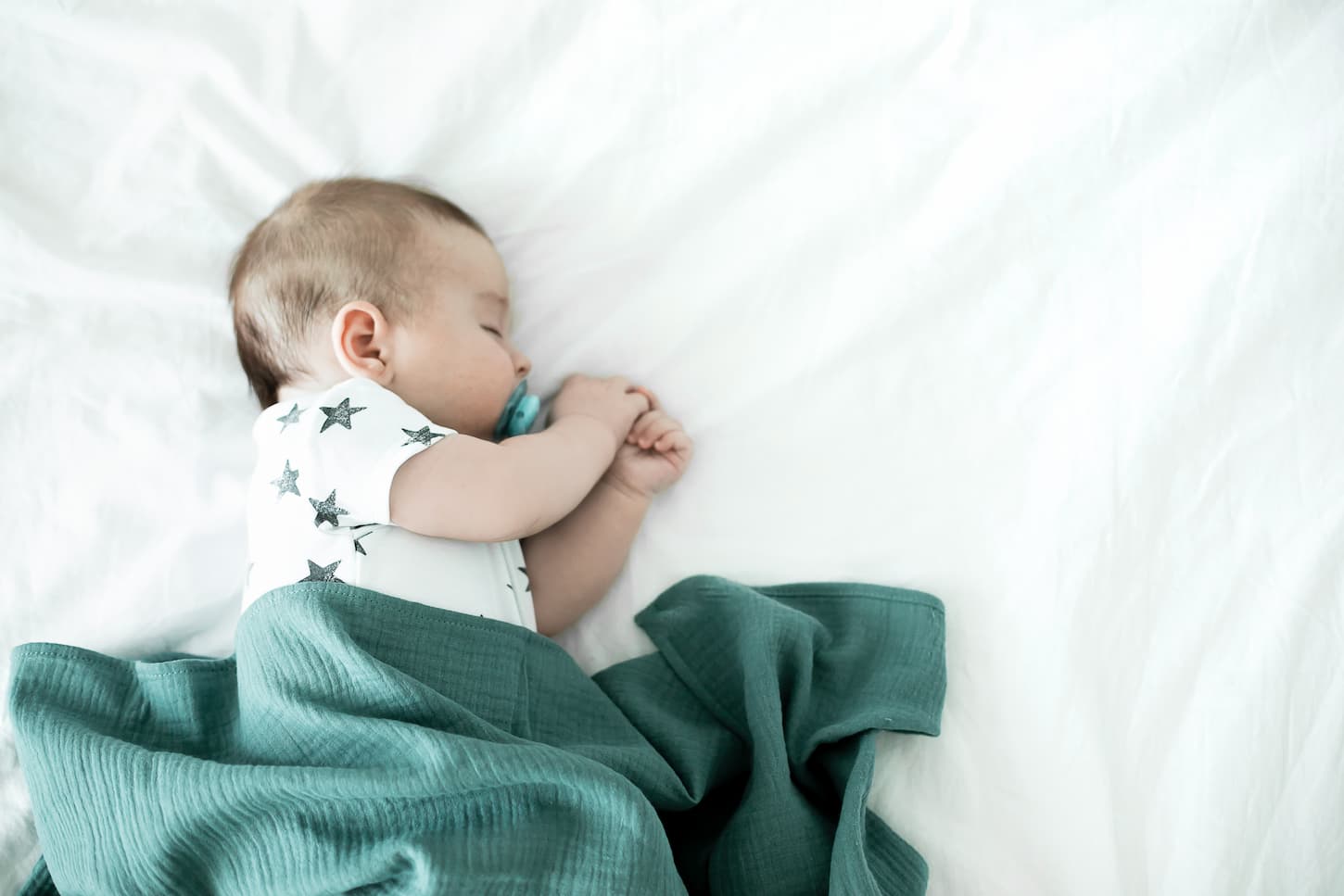
How do you Break the Habit of a Baby Sleeping in your Arms?
To help parents break their baby’s habit of sleeping in their arms, use one of the many sleep training methods to transition a baby to sleep in a crib over time. Build a regular nap and bedtime routine that encourages a baby to sleep without being held.
For babies less than 12 weeks old, use the 5 S’s technique, where the parents use swaddling and shushing to soothe their baby. Plan on using a bedtime routine to help the baby sleep, or start sleep training the baby if they’re old enough.
To learn how to break the habit of a baby sleeping in our arms, let’s take a look at these eight essential tips below:
Tip #1 – Use the 5 S’s
The 5 S’s stand for swaddling, shushing, side, setting, and sucking; they are alternative ways to comfort a baby without holding or rocking them. The five S’s are a fantastic way to help a baby self-soothe.
1. Swaddling
Swaddling is a fantastic way to soothe babies because the pressure mimics a parent’s touch and makes babies feel warm, snug, and secure. In addition, swaddling helps recreate the womb environment and make babies feel like we’re holding them, resulting in reduced anxiety.
Don’t over-swaddle a baby – too much swaddling can cause overheating, which increases the risk of SIDS. Also, stop swaddling them when they can roll over because they might be able to wriggle loose and suffocate. Most babies can roll over between 2 and 4 months old.
2. Shushing
Parents can try shushing their babies to help them settle. Shushing imitates white noise, which most babies find soothing because it replicates the sounds they hear in the womb. Parents should make long, drawn-out, shushing sounds close to their baby’s ear at a volume that matches their crying.
Instead of shushing, we can play white noise to our babies from one of the many apps available on our smartphones.
3. Side
Most babies will calm down if placed on their stomachs or side. This is because putting babies on their side or stomach activates a calming reflex that helps most babies relax.
However, parents should never let their baby sleep on their stomach or side because it can increase the risk of SIDS. If a baby falls asleep on their side or stomach, always lay them on their back to continue the nap.
4. Setting (or swinging)
Babies are susceptible to their environment, so ensure the setting is calm and relaxing about half an hour before bedtime. Avoid bright lights, noise, and activity – dim the lights and play soothing music or white noise to help your baby wind down for bed.
Babies also do well being swung side to side. This can be good to help them calm down, but it won’t help them sleep. So focus on the setting, too.
5. Sucking
Sucking is one of the most critical reflexes for a baby, it helps them feed, and it also helps them calm down. According to this study, sucking on a pacifier has an analgesic effect on babies and can relieve pain.
- Wait until the baby has a good feeding regime before using a pacifier at around four weeks old. The AAP recommends that er wean babies off a pacifier before six months because this is when babies can form habits. After this age, pacifiers may affect their development.
- Pacifiers may also help reduce the chances of SIDS.
Speaking as a nurse who’s treated countless babies over the years, using a pacifier as a way to calm babies really works. It especially works if you dip the end of a pacifier in some sugar water, though I don’t have the recipe that our hospital used, nor do I know how to keep that sterile. If there’s enough interest, I suppose I could research it and write an article on it.
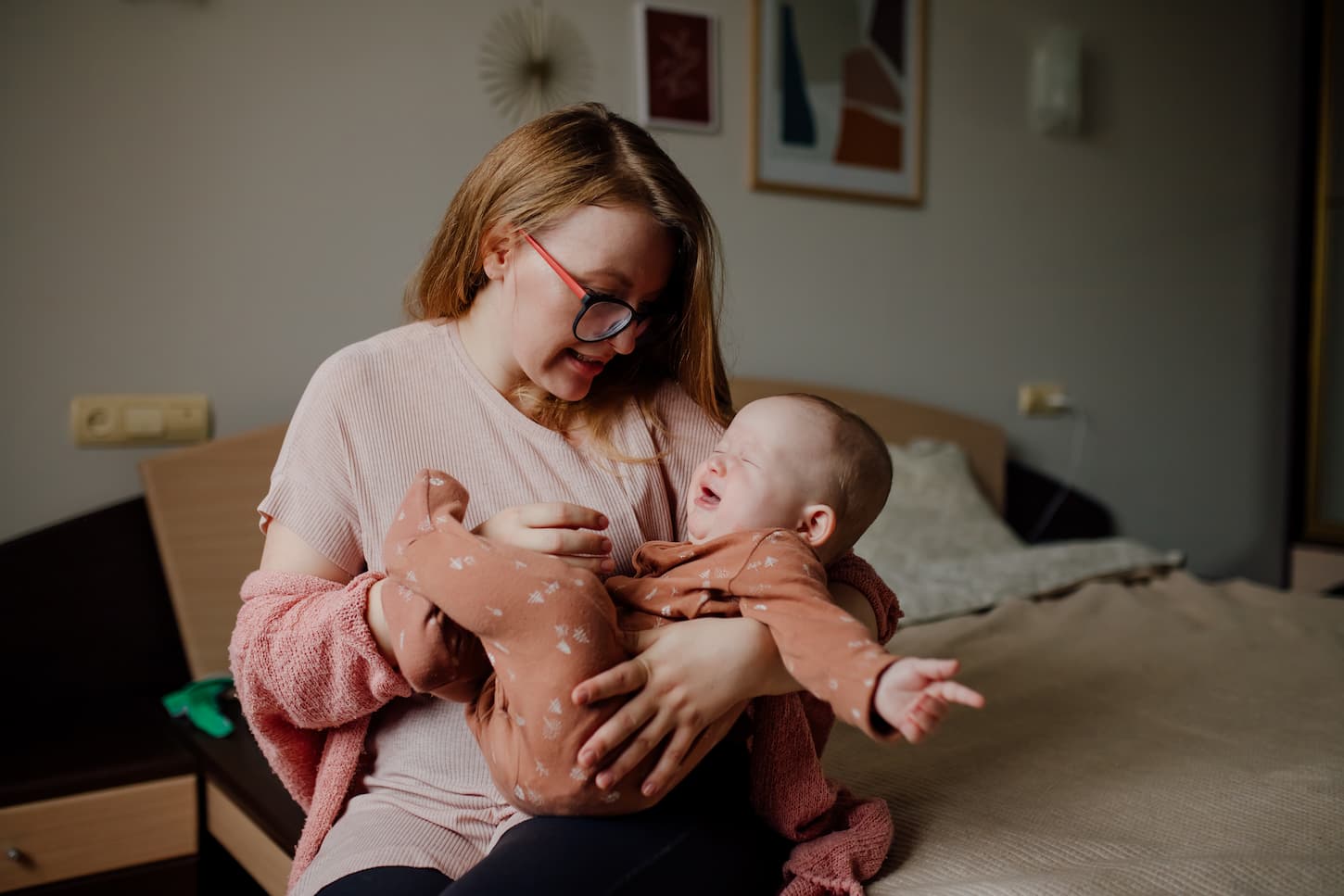
Tip #2 – Don’t feed or rock your baby asleep
Babies can easily become dependent on certain things to fall asleep, known as sleep associations. Sleep associations can be positive or negative.
Negative sleep associations depend on parents physically interacting with their babies to help them fall asleep such as holding, rocking, bouncing, feeding, or walking around in a stroller.
Positive sleep associations don’t necessarily mean that parents need to have physical contact with their baby. For example, this includes a good bedtime routine, singing lullabies, or creating a calm environment.
Use positive sleep associations instead of negative ones to encourage the baby to self-soothe and become a better sleeper.
Want to read more about sleep associations? Here are some articles I wrote that can help you out.
- How are Sleep Associations and Sleep Training Related?
- How are Sleep Associations and Sleep Regressions Related?
Tip #3 – Focus on a bedtime routine
Setting a bedtime routine for our babies is a fantastic way to get them to sleep independently. Babies love patterns because they feel safe and secure knowing what’s happening next. We can start with a bedtime routine when our babies are around 6 to 8 weeks old.
Here are some tips on how to create a good bedtime routine for our babies to help them fall asleep:
- Begin the routine around 30 minutes before bedtime.
- Always stick to the exact times and do things in the same order.
- Dim the lights.
- Make sure it’s quiet.
- Put some soothing music on.
- Give your baby a warm bath.
- Put them into pajamas.
- Give the baby a massage.
- Tell stories or sing lullabies.
No matter how your bedtime routine looks, focus on what makes your child sleepy. Don’t do things that excite or rile them up. You can read more about bedtime routines here: Baby’s Bedtime: What’s too early, what’s too late, and what’s just right?
Tip #4 – Act on their sleep cues
Instead of waiting until our babies are asleep before putting them in their crib, watch out for their sleep cues and put them in when they’re drowsy and almost asleep.
Parents will know their babies are tired when they become quiet and stare off into space. If they act on their babies’ sleep cues and put them in their crib when they’re drowsy, eventually, they’ll associate their crib with sleeping instead of being held.
Here’s a list of some of the things a baby will do when they’re tired:
- Yawn.
- Stare into space.
- Become quiet and lethargic.
- Suck their fingers or toes.
- Jerk their limbs.
Need to know more about sleep cues? Gotcha covered in this article: How to Recognize and Use Your Child’s Sleep Signs and Cues.
Tip #5 – Use a hot water bottle to warm their crib up
Heating a baby’s crib with a hot water bottle before putting them down might trick them into thinking they’re still close to us. Instead, ensure the crib isn’t too hot before putting the baby down, and never leave the water bottle in the crib with the baby because they might suffocate on it.
Also, a baby won’t sleep well if they’re too warm, and overheating will increase the risk of SIDS.
Tip #6 – Hold your baby in the crib
If a baby becomes unsettled in the crib when putting them down to sleep, parents should try placing their hands on the baby instead of picking them up. The contact on their body lets them know we’re there for them and helps them feel warm and secure.
We should gradually reduce contact with our babies and offer them verbal reassurance outside the crib.
Tip #7 – Use an eat – play – sleep routine
As we’ve mentioned, babies love routines and one way we can help them fall asleep during the day and ensure their needs are met is an Eat-Play-Sleep routine. It’s a simple routine that helps our baby get in the mood for sleeping and helps break the habit of feeding or holding.
- Eat – First, feed the baby so they won’t wake up because they’re hungry.
- Play with the baby – interact with family members, tell stories, play with toys, or go for a walk and change their diaper. Playing with a baby will help tire them out – but don’t do anything that will overstimulate them.
- Sleep – After playing, ensure the environment is calm and quiet, make some white noise, and watch out for the baby’s sleep cues. Then, please put them in their crib for a nap when they get drowsy.
Want to know more about this routine? I’ve got a guide for you here: Baby Wake Times: a Beginner’s Guide to Wake Windows by Age.
Tip #8 – Start sleep training
Older babies who insist on sleeping in their parent’s arms can be sleep trained to break the habit. Sleep training is the perfect way to help babies sleep independently and teaches them positive lifelong sleeping habits.
Sleep training benefits parents because they do too when a baby sleeps better.
Depending on their development, parents can start sleep training when their baby is around 5 or 6 months old. Always consult a pediatrician before beginning sleep training to ensure the baby is ready for it.
Each baby is different regarding sleep training – some will take to it in a few days, while others may take a few weeks.
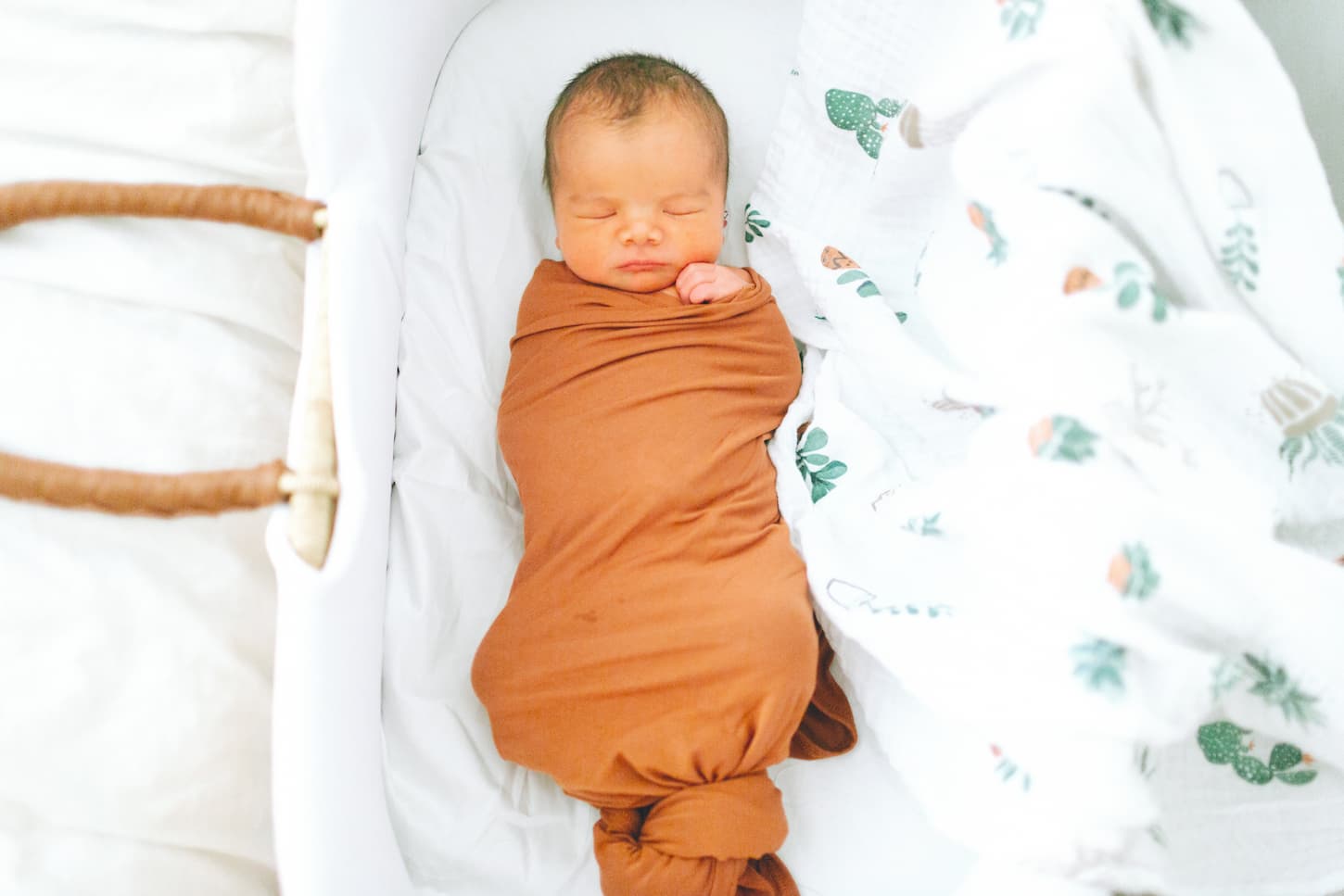
Best Products to Break the Habit of Baby Sleeping in Arms
When you’re transitioning your baby from sleeping in your arms to sleeping in a bed, it can help to have the right products to make things easier. Here are a few such products.
Get a great white noise machine.
- This one is my favorite, and that link explains why.
- But this one on Amazon is a great choice for parents who want to have a light and sound machine in one (and it comes with an app to control it all, which is cool).
Get a swaddle if your baby is young enough to be swaddled. This option, available on Amazon, comes in a variety of fun patterns and fabric options.
Get a glow-in-the-dark pacifier for bedtime. It’s so much easier to find in the dark than a non-glowing version. These ones, available on Amazon, are similar to some my daughter loved. If that brand isn’t one you know that your baby loves – don’t stress. Most brands offer a glow-in-the-dark version of the kind of binky your baby loves.
Key Takeaways and Next Steps
It’s okay for newborn babies to fall asleep in our arms – it helps them feel safe and secure, and it’s a fantastic way to calm them down and get them asleep.
However, if a baby is older than three months old and needs to be in our arms to fall asleep, we need to get them used to falling asleep in their crib.
Otherwise, they will form a negative sleep association and need to be held in our arms every time they go to sleep.
There are many ways to break the habit of a baby sleeping in our arms – we can use the 5 S’s to soothe our babies from outside the crib and swap negative sleep associations such as feeding and rocking for positive ones like a good bedroom and bedtime routine.
Now that you know more, make sure that you give this article about mattresses a read next. That way, you’ll have the right kind of mattress in your crib so that your baby sleeps safely.
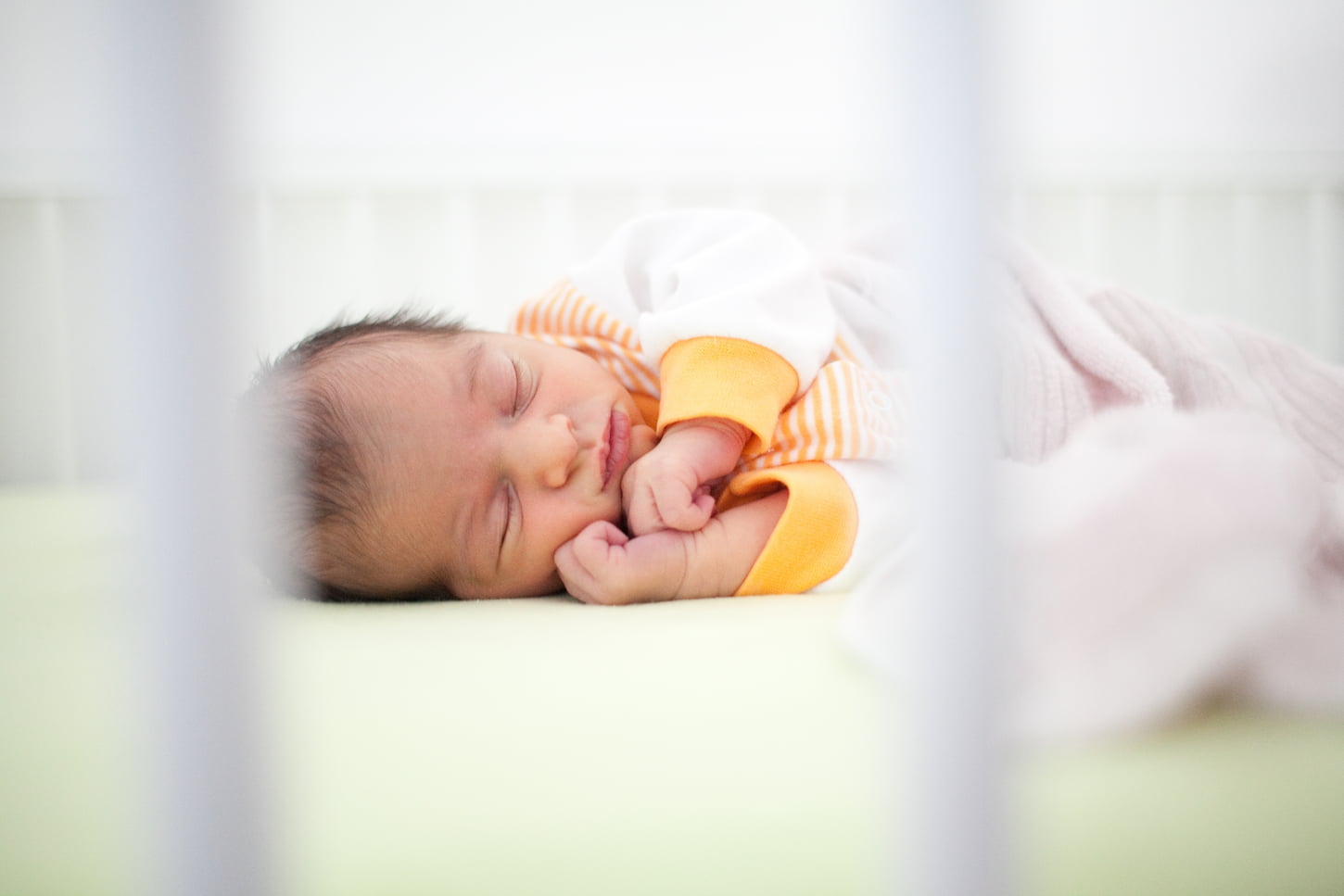
Resources
Learning about parenting or sleep training techniques is important to learn from various reputable sources. These are the sources used in this article and our research to be more informed as parents.
- “Analgesic Effect of Non-Nutritive Sucking in Tm Neonates: A Randomized Controlled Trial.” ScienceDirect, ScienceDirect, www.sciencedirect.com/science/article/pii/S1875957219304887. Accessed 9 June 2022.
- Burnham, Melissa M., et al. “Nighttime Sleep-Wake Patterns and Self-Soothing from Birth to One Year of Age: A Longitudinal Intervention Study.” Journal of Child Psychology and Psychiatry, vol. 43, no. 6, 2002, pp. 713–25. Crossref, doi:10.1111/1469-7610.00076.
- Hauck, Omojokun, Siadaty, Fern R., Olanrewaju O, Mir S. “‘Do Pacifiers Reduce the Risk of Sudden Infant Death Syndrome? A Meta-Analysis.’” National Library of Medicine, PubMed.gov, 10 Oct. 2005, pubmed.ncbi.nlm.nih.gov:443/16216900.
- Jean Hailes for Women’s Health. “The Feed-Play-Sleep Routine.” Jean Hailes, 10 Feb. 2020, www.jeanhailes.org.au/news/the-feed-play-sleep-routine.
- Lewis, Rhona. “Using the 5 S’s to Soothe Your Baby.” Healthline, 18 June 2020, www.healthline.com/health/baby/5-s-baby#shush.
- Natale, Sumi Sexton|Ruby. “Risks and Benefits of Pacifiers.” American Family Physician, 15 Apr. 2009, www.aafp.org/afp/2009/0415/p681.html.